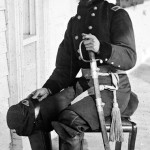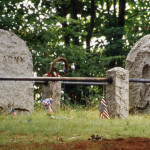Remembering Washington’s complicated first governor Isaac Stevens
Sep 1, 2023, 11:20 AM | Updated: 11:20 am

The death of Isaac Stevens, Washington Territory’s first governor, is depicted heroically in this lithograph created by Alonzo Chappel in the 1860s. (Courtesy Charles V. Mauro)
(Courtesy Charles V. Mauro)
Highlanders! Highlanders! Follow your general!
As a thunderstorm raged in the skies above the Virginia countryside, those were the words shouted by Isaac Stevens, Washington Territory’s first governor.
Stevens had left the Northwest and was leading the men of the 79th New York Volunteer Infantry into battle against Confederate forces during the Civil War on Sept. 1, 1862.
The consensus among historians is that Stevens was something of a 19th-century archetype: a can-do kind of guy, hard-headed and stubborn, prone to heavy drinking, and not worried about who he had to step over (or step on) to get things done. And historians mostly agree that this was the way one had to be in those days in order to achieve large and complex goals.
The West Point graduate and Mexican War veteran is forgotten by most contemporary Washingtonians, though historians and Native Americans, and perhaps residents of Stevens County and Lake Stevens, are keenly aware of some parts of his legacy.
“He looms large in the history of the territory and the state,” said David Nicandri, retired longtime director of the Washington State Historical Society. “However you calculate these things, Isaac Stevens has a larger footprint or takes up a greater volume of concern and consciousness than the entire balance of the territorial officialdom up until the time Washington becomes a state in 1889.”
Most agree that Stevens was a complex figure who accomplished much. He grew up in Massachusetts, and was appointed by President Franklin Pierce in 1853 to serve as governor of the newly created Washington Territory. On the way west, he led a surveying crew to identify and map a northern transcontinental railroad route. After serving four years as territorial governor and then four years as Washington’s territorial representative in Congress, he became a general in the Union Army during the Civil War.
But Nicandri says that Stevens’ legacy is complicated somewhat by the treaties he negotiated with Native Americans in the Northwest in his additional role as superintendent of Indian Affairs.
Settlers were anxious to move into parts of Washington Territory that had been home to Native Americans for millennia; Stevens was under pressure to get agreements signed and get Natives moved onto reservations so that those settlers could settle. Some say that misunderstandings created by the hastily negotiated treaties led to deaths and loss of property by sparking the Indian War of 1855-1856.
By most accounts, much of the treaty process led by Stevens appears hurried and sometimes even ham-handed, Nicandri says.
“As a result of that, he gets over typified as kind of a genocidal character, sort of in the 20th century mode of a Hitler or Stalin or some totalitarian type like that,” Nicandri said.
Nicandri sees a more apt parallel in a figure from the early 19th century.
“A more appropriate historical analogy, biographically speaking, is Napoleon,” Nicandri said. “[Stevens] certainly had a Napoleonic streak, in fact, doubly so, because like Napoleon himself, he was small in stature, probably overly conscious about prerogatives and his place in the world, which did a lot to inform his character.”
As early as the turn of the 20th century, critics assailed Stevens for the treaty process, yet also acknowledged that his more strident traits were what had enabled him to accomplish so much.
Famous pioneer and early Washington historian Ezra Meeker described Stevens this way:
“He would take no counsel, nor brook opposition to his will. He believed in himself, and he was willing to take all responsibility. He would not shrink from the severest strain of labor nor tolerate idleness in others. He was scrupulously honest in the handling of public money . . . he was possessed of small measure of patience, a characteristic so essential in dealing with Indians. His education had been under military discipline of strict submission to those in command and his habits of obedience had been formed under the experience of war. With these defects of character and training, it is easy to see that his dealings with the Indians were from the first doomed to failure.”
Kent Richardson probably knows more about Isaac Stevens than anybody. He’s professor emeritus of history at Central Washington University in Ellensburg. He also wrote the definitive biography of Stevens back in the 1970s (which is still in print).
Richardson takes a more nuanced view of Stevens and of the treaties. He says that the treaty process is often misunderstood and sometimes mischaracterized.
“Stevens was carrying out fixed government policy, and however well or however badly that policy often worked out, it was, by the standard of the time, an enlightened policy,” Richardson said.
Government officials wanted Native Americans to shift to an agrarian way of life. Treaties were meant to facilitate Natives settling on reservations, initiating farming, and accepting promises of money and other material assistance in exchange for giving up claims to vast tracts of western lands. But creating reservations often meant combining vastly different tribal groups into single geographic and political units, despite deep cultural and even language differences.
“No one in the government was saying ‘Oh, let’s go wipe out these heathens,’” Richardson said. “They tried to formulate a path for them to be temporarily aided by the government and to eventually blend into the mainstream, the melting pot of American society.”
Richardson also says that we shouldn’t judge Stevens’ actions in the 1850s by the standards of 2016; he says it was a much different time, with much slower means of travel and communication.
“In my view, he did about as good a job as anyone could have done under the pressures of the time,” Richardson said. “If he didn’t do something quickly, the settlers would just have overwhelmed the Native population and there couldn’t have been any treaties. [Native Americans] just would’ve been shoved aside.”
The biggest insurmountable issue facing Stevens, was the fundamental cultural and societal differences between the formal governmental structure of the United States and the more fluid structure of the Native American communities, Richardson says. The notion that tribes could elect a leader who could then negotiate on the entire tribes’ behalf, Richardson says, is a construct that just didn’t mesh with reality.
“In many ways, it’s surprising it worked as well as it did despite all the flaws and imperfections,” Richardson said.
One place where Stevens’ legacy feels less complicated and more tangible than it does in the Evergreen State is Fairfax County, Virginia.
Charles V. Mauro lives a few miles from the site of the Battle of Chantilly, which the Confederates called the Battle of Ox Hill. He’s been making maps and studying the battle for decades. A few years ago, he published a book about it.
Mauro says Stevens’ legacy as a Union officer is pretty clear.
“Major General John Pope wrote about him,” Mauro said. “[Pope] said [Stevens] was a man of superior abilities full of marked skill and courage.”
Mauro also says that Stevens was probably well respected by the 2,000 men he led into battle on that stormy day in 1862.
Stevens’ objective during the Battle of Chantilly was to march across Virginia and cut off a group of about 15,000 Confederate troops who were on their way to try to encircle and destroy the Union Army. The day before, the Union had been defeated at the Battle of Bull Run, and the troops were headed back to regroup at garrisons in and around the nation’s capital.
It was an hour or so into the battle, around 5 p.m., when the regiment’s flag bearer was wounded and fell. Mauro says that in that era, troops literally “followed the flag” during combat in order to know which way they were headed.
General Stevens saw the flag fall, then took it upon himself to grab the staff off the ground, to call out to his troops, and then carry the flag toward the enemy.
Mauro says it was just moments after urging his men to follow him that a bullet struck the 44-year-old Stevens in the temple. Stevens, along with his dream to one day to return to Washington and serve as a US senator, was no more.
Earlier, General Stevens’ 20-year old son Hazard Stevens was wounded in the battle, fighting near his father. Hazard Stevens survived the war, and lived to see the dedication of a monument and plaque near the places where his father, and General Philip Kearny, both fell.
Charles Mauro says that the heavy downpour and thunderstorm truncated the battle after just a few hours. Early the next morning, the Union Army marched back to Washington, DC and escaped the Confederates.
Back in the other rainy Washington, the telegraph connection was still a few years away. So it likely took weeks for people to learn of Stevens’ death.
Though he was mourned at the time, a monument to Stevens or a statue of the diminutive general are hard to find in the Evergreen State. But historian David Nicandri says that Stevens’ legacy is secure.
“He’s pretty firmly entrenched in the firmament of the state’s history,” Nicandri said.
And that firmament of state history includes the treaties themselves, which function as de facto founding documents of Native American tribes, and certified contracts between the tribes and the federal government. The Yakama Nation even features an image of a treaty on their official logo.
Suquamish Tribal Chairman Leonard Forsman says that while Isaac Stevens may have rushed the treaties and that the process had other flaws, their more positive impacts are felt every day in modern tribal life.
Tribal members, Forsman says, are in dialog with the Treaty of Point Elliott,“multiple times a day, whether it be healthcare, natural resource protection, real estate issues, fisheries management, clean water, education.”
Forsman says that many Native Americans have even memorized particular sections.
“We’re pretty familiar with Article Five, about the right to Indian fisheries in customary places,” said Forsman. “Everybody can probably recite that, and also the description of our reservation, ‘two sections of land surrounding the bight at Noo-sohk-um.’”
Non-Native memory of Governor Isaac Stevens is understandably somewhat different.
“White people, I’ll call them that,” said David Nicandri, “tend to think of the 1850s as being this long-distant period, not quite back to the Age of the Dinosaurs, but halfway there, maybe.”
“When you’re talking with Native people,” Nicandri said, “it’s as if Isaac Stevens has just left the room.”
This story was originally published August 31, 2016
You can hear Feliks every Wednesday and Friday morning on Seattle’s Morning News with Dave Ross and Colleen O’Brien, read more from him here, and subscribe to The Resident Historian Podcast here. If you have a story idea, please email Feliks here.


















